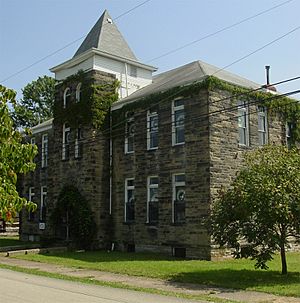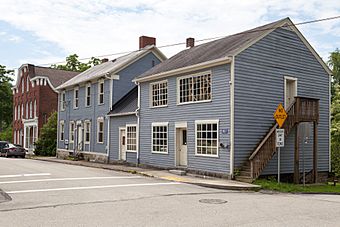Greensboro, Pennsylvania facts for kids
Quick facts for kids
Greensboro, Pennsylvania
|
|
|---|---|
|
Borough
|
|

Greensboro Public School
National Register of Historic Places |
|
| Etymology: Nathanael Greene | |

Location of Greensboro in Greene County, Pennsylvania.
|
|
| Country | United States |
| State | Pennsylvania |
| County | Greene |
| Established | 1781 |
| Area | |
| • Total | 0.15 sq mi (0.38 km2) |
| • Land | 0.11 sq mi (0.28 km2) |
| • Water | 0.04 sq mi (0.10 km2) |
| Elevation | 800 ft (200 m) |
| Population
(2020)
|
|
| • Total | 266 |
| • Estimate
(2023)
|
253 |
| • Density | 2,444.44/sq mi (941.51/km2) |
| Time zone | UTC-4 (EST) |
| • Summer (DST) | UTC-5 (EDT) |
| Area code(s) | 724 |
| FIPS code | 42-31192 |
Greensboro is a small town, called a borough, located in Greene County, Pennsylvania, United States. In 2020, about 266 people lived there. This was a small increase from 260 people in 2010.
Contents
Geography of Greensboro
Greensboro is in the southeastern part of Greene County. It sits on the west bank of the Monongahela River. Across the river are New Geneva and the mouth of George's Creek. The town is surrounded by Monongahela Township to the north and west. Across the river to the south and east is Nicholson Township in Fayette County. The county line runs right through the middle of the river.
The closest bridges over the river are the Masontown Bridge, about 8 miles north, and the Albert Gallatin Memorial Bridge, about 6 miles south.
The borough covers a total area of about 0.15 square miles (0.38 square kilometers). Most of this area, about 0.11 square miles (0.28 square kilometers), is land. The rest, about 0.04 square miles (0.10 square kilometers), is water.
History of Greensboro
Early Settlements and Naming
Greensboro's history goes back to the Mingo tribes, part of the Iroquois people. They called this area "Delight" because of its rich farmland. Around 1752, settlers from the east and south began to arrive. The first European settler in Delight was John Badolet, an explorer and trader.
In the early 1780s, Elias Stone bought the land. He divided it into streets and blocks, which still have their original names. On February 9, 1790, Stone's village was named "Greensburgh." Later, its name was changed to "Greensboro." This was done to honor Nathanael Greene, a hero of the Revolutionary War. Greene County was also named after him in 1796.
Because of its location on the river, Greensboro quickly became an important trading spot. It was a stop for settlers and travelers heading north to Pittsburgh or west.
Glassmaking and Early Growth
Albert Gallatin was a key figure in Greensboro's early development. He later became the United States Secretary of the Treasury. In 1795, Gallatin bought land in Greensburgh and also in New Geneva, across the river. He met German glassblowers who were heading to Kentucky. Gallatin convinced them to settle near Greensburgh instead.
With his help, they started the New Geneva Glass Works in New Geneva. Around 1805, Gallatin sold his share. The glassworks then moved across the river to Greensboro. This northern part of Greensboro became known as "Glassworks."
Glassmaking was a major industry for many towns along the Monongahela River. This included Pittsburgh and smaller towns like Greensboro. The early glassworks showed that good glass could be made using local resources and river transport.
Stoneware and River Trade
After the American Civil War, making stoneware became Greensboro's main industry. They also made clay tiles for roofing. Greensboro's stoneware potteries were very busy in the mid-1800s. Skilled artists used local clay to create unique blue-gray stoneware. This pottery was sold in many places.
Greensboro's location at the start of the river's calm waters made it important. It became a shipping point for southern Greene County and parts of northern West Virginia. This helped the town grow into a social and cultural center.
By the 1850s, a system of locks and dams was built on the Monongahela River. This allowed boats to travel year-round from Pittsburgh to Greensboro. However, in the 1880s, Greensboro's pottery and tile market declined. Other producers became more efficient. Also, river transport extended further south to Morgantown, making Greensboro less central.
During this time, many churches were built in Greensboro. Different groups like Lutherans, Presbyterians, Baptists, and Methodists established their places of worship.
The Industrial Era and Today
Around the early 1900s, the industrial age arrived. Western Pennsylvania played a big role in this change. The Greensboro area was rich in coal, a mineral that made the region famous. Greensboro was already an established town with shops and trade. It quickly became a busy center for new "coal patch towns" that grew up nearby. These towns housed miners during the Coal Rush.
Coal became very important. Neighborhoods like Penn-Pitt were originally company housing for miners. Thousands of immigrants from Eastern and Southern Europe came to the region. They brought new customs and cultures.
Mining was dangerous work, and miners often earned low pay. Many workers had to buy goods from "company stores" and rent homes from the mining companies. This system was sometimes called "wage slavery" because workers felt trapped. To fight for better conditions, unions like the UMWA were formed. Events like the "Red Neck Revolution of 1921" helped end this era.
The Robena mine near Greensboro was once the largest mine in the world in 1946. But it also saw tragedy. In December 1962, 37 miners died in an explosion at Robena No. 3. This showed how risky mining could be.
Coal shaped the region and its people. It brought wealth to Greensboro and the Monongahela Valley. But this period did not last forever. As coal reserves ran out and mining methods changed, many coal towns faded away.
Today, coal is still important to Greene County's economy. However, Greensboro and other towns are looking for new ways to grow. They are focusing on things like ecotourism (travel to natural areas), agritourism (farm visits), and community-supported agriculture (local food). Fishing, hunting, hiking, and boating are also becoming popular activities.
Historic Industries
Pottery Making
Pottery was a very important industry in Greensboro's early days. Alexander Vance started the first pottery business in the early 1800s. He and his brother James made stoneware from local red clay. It had a unique color.
David Boughner took over the business in 1819. He was the first to use a salt kiln to fire the stoneware. This was an advanced method for the time.
Later, James and William "Leet" Hamilton started their own pottery company in 1850. Their company, James Hamilton and Company, was located along Water Street.
In 1866, Leet's son Frank Hamilton and his son-in-law John Jones took over. They expanded the business, selling their pottery more widely. Their company, Hamilton and Jones, was a rival to James Hamilton's company. It was also known as Star Pottery or Union Works.
The company made pottery for over thirty years and was well-known. However, competition grew, and a big fire in 1897 destroyed their plant. They tried to restart, but it was too difficult.
James Hamilton kept control of his firm until 1880. He eventually sold his share to Thomas Reppert and W.T. Williams. Reppert later bought the whole business, but Williams bought back in. Together, Reppert and Williams sold stoneware to dealers in at least four states.
By the start of World War I, most pottery production in Greensboro had stopped. The year 1916 is generally seen as the end of stoneware manufacturing there.
Glass Production
Albert Gallatin and his partners helped start the "glassworks district." They worked with German glassblowers like Christian Kramer and others.
Gallatin met the glassworkers in 1792. They were planning to start a glass factory in Kentucky. Gallatin convinced them to set up their business on his land in New Geneva instead.
The glassblowers chose New Geneva. They formed a partnership with Gallatin and James A. Nicholson. Until 1803, the New Geneva Glass Works made window glass for pioneers. They also made bottles, bowls, and other items.
When Gallatin became a government official, he left the glass business. In 1807, the glassworks moved to Greensboro. This was because coal was discovered there.
Using coal instead of wood made glass production much easier. Greensboro had plenty of coal and nearby sand. These resources supplied the glassworks until it closed in 1849.
The Kramer families managed and operated the old glassworks. They produced window glass. Individual glassworkers also blew bottles, bowls, and ornaments as gifts.
Glass was loaded onto barges from special docks behind the factory. It was shipped up and down the Monongahela River. This allowed early settlers to have glass windows, which were once a luxury.
Preserving Greensboro's History
Greensboro understands how important it is to keep its past alive. Residents, leaders, and community groups work together to teach about and protect the town's rich history. They form partnerships between public and private groups to achieve this. Over $3 million has been invested in projects to preserve Greensboro's heritage.
In 1985, the community realized they needed to document their history. They created a Historic District to protect much of the town. In 1987, a local resident, Betty Longo, began writing down the memories of an elderly resident, Mary Black Carr. These stories are a valuable record of the community's past.
The Nathanael Greene Historical Foundation and the borough council have led many preservation efforts. For example, they worked to save and restore the Log House. They partnered with the Army Corps of Engineering to move it. They also worked with the Pennsylvania Department of Labor and Industry's Civilian Conservation Corps. This group provided the workers needed to restore the building.
The Log House is now an important historic building. It is also used as a meeting place for the community. It hosts the annual Christmas Party and can be rented for private events. The money from rentals helps the town.
Other projects include creating a guide for homeowners in the Historic District. A town website shares Greensboro's history. Grant money helped build a boat launch. Also, 28 homes were refurbished using state funds. Community festivals are held yearly to display historical items. Greensboro continues to work to preserve its past and improve its future.
Greensboro Historic District
|
Greensboro Historic District
|
|

Looking southeast down County Street from its intersection with 1st Street
|
|
| Lua error in Module:Location_map at line 420: attempt to index field 'wikibase' (a nil value). | |
| Location | Roughly bounded by County, Second, Walnut, Front and Clear Sts. and the Monongahela R., Greensboro, Pennsylvania |
|---|---|
| Area | 14 acres (5.7 ha) |
| Built | 1791 |
| Architect | Parreco, James; others |
| Architectural style | Queen Anne, Italianate |
| MPS | Greensboro--New Geneva MPS |
| NRHP reference No. | 95000118 |
| Added to NRHP | November 17, 1995 |
The Greensboro Historic District was created in 1995. It includes an area of about 14 acres (5.7 hectares). This district has many buildings and sites that show the town's importance. They highlight its history in industry, trade, architecture, and transportation.
The district's industrial and transportation importance was mostly in the 1800s. But its trade and architecture are important into the early 1900s. Five other buildings outside the district are also historically important.
Inside the Historic District, there are 36 buildings. Twenty-nine of these buildings are considered historically significant. The wharf, built around the time of the Civil War, is also in the district. There is also an archaeological site where the James and Hamilton Company pottery works once stood.
The district is known for its architecture. The buildings show different popular styles from the 1800s to the early 1900s. These include Italianate and Bungalow styles. Many homes are in the Queen Anne style. Greensboro has a wide range of architecture from its early settlement to the 20th century. The period of historical importance for the district is from 1750 to 1949. The buildings include businesses, churches, a theater, and homes.
Besides the Historic District, several other buildings in Greensboro are listed on the National Register of Historic Places. These include the Greensboro Public School, the Alexander V. Boughner House, the Peters-Graham House, the James Parreco House, and the James Jones House.
Population Information
| Historical population | |||
|---|---|---|---|
| Census | Pop. | %± | |
| 1880 | 482 | — | |
| 1890 | 427 | −11.4% | |
| 1900 | 399 | −6.6% | |
| 1910 | 442 | 10.8% | |
| 1920 | 516 | 16.7% | |
| 1930 | 598 | 15.9% | |
| 1940 | 625 | 4.5% | |
| 1950 | 651 | 4.2% | |
| 1960 | 505 | −22.4% | |
| 1970 | 439 | −13.1% | |
| 1980 | 377 | −14.1% | |
| 1990 | 307 | −18.6% | |
| 2000 | 295 | −3.9% | |
| 2010 | 260 | −11.9% | |
| 2020 | 266 | 2.3% | |
| 2023 (est.) | 253 | −2.7% | |
| Sources: | |||
In 2000, Greensboro had 295 people living in 117 households. About 80 of these were families. The population density was about 2,699 people per square mile. There were 140 housing units.
Most residents (98.64%) were White. A small number were Asian (0.68%) or from two or more races (0.68%). About 1.69% of the population was Hispanic or Latino.
In 2000, about 25.8% of the population was under 18 years old. About 19.3% were 65 years or older. The average age was 39 years.
Notable People
- Robert E. Eberly (Eberly Foundation), who worked in mining and oil, was born in Greensboro in 1918.
- Todd Tamanend Clark, a poet and composer, was born in Greensboro in 1952.
See also
 In Spanish: Greensboro (Pensilvania) para niños
In Spanish: Greensboro (Pensilvania) para niños



